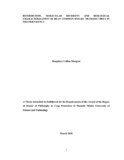| dc.description.abstract | on bean (Phaseolus vulgaris L) is the main high protein legume crop in the cropping system of
western Kenya. The crop is mainly grown by small-scale farmers for food and cash. Despite its
importance, common bean yields are low (<1.0 t/ha) and declining. Bean production is constrained by
plant viruses among other factors. Of the viruses infecting common bean, Bean Common Mosaic
Necrosis Virus (BCMNV) is a widespread virus that causes Bean Common Mosaic Disease (BCMD)
either singly or in mixed infection with Bean Common Mosaic Virus (BCMV). In Kenya, limited
common bean varieties with resistance to BCMNV strains have been reported. In addition, there is
inadequate documentation on the strains of the virus infecting common bean. Moreover, the extent of
other hosts and distribution of the virus in main growing areas is still not known. This information is
crucial in devising control measures. This study therefore, sought to determine the distribution and
characterization of BCMNV isolates from western Kenya. The specific objectives were to determine
incidence and severity of BCMD in western Kenya, to determine molecular characteristics of
BCMNV and to screen local germplasm for resistance to BCMNV. In October 2016 and May 2017,
two diagnostic surveys for BCMD were conducted in 7 counties of Western Kenya namely Bungoma,
Busia, Homa bay, Nandi, Vihiga, Kakamega and Siaya. In total 270 bean farms were visited, 150 in
the long rain and 120 in the short rain seasons, respectively. Leafy samples showing virus-like
symptoms were collected and analysed by Enzyme linked immunosorbent Assay (ELISA) and next
generation sequencing (NGS). Extraction of total RNA from ELISA positive samples was done using
RNeasy Plant Mini Kit and NGS carried out following Illumina protocol to determine diversity of the
virus. NGS data was trimmed and the sequence reads assembled into contigs, which were analyzed
against virus sequence database. Phylogenetic analyses and comparisons were performed using
MEGA7 program. Sixteen popularly grown bean cultivars together with cowpea, soybean and
groundnut were planted in a greenhouse in a randomized complete block design with three replicates.
The plants were inoculated with BCMNV isolate at 3-leaf stage. Data was taken weekly for 3 weeks
on type of symptoms expressed and number of plants infected. ANOVA was used to compare disease
incidence and severity means and least significant difference (L.S.D.) values were used to separate
the significant different means at P ≤ 0.05. Symptoms of mosaic, downward curling, vein necrosis,
local lesions, stunting or a combination of these were observed during both surveys. Disease
incidence among the counties varied significantly (p=0.05). Mean virus incidence was higher (41.8%)
in the short rain season compared to long rain season (35.6%). Kakamega county had the highest
mean virus incidence (47.6%) while Siaya had the lowest (31.6%). The mean BCMD severity was
highest (2.3) in Kakamega county and lowest (0.5) in Siaya. There was a strong positive correlation
between viral disease incidence and severity (r=0.843; p<0.001). Of the 240 symptomatic leaf
samples collected, 59 were ELISA positive. NGS technology revealed full-length sequence of
BCMNV from an isolate BG 12 from Bungoma County with a genome of 9584 nt in length.
Phylogenetic analysis of full-length sequences available through the Genbank clustered the isolate
with the Tanzanian isolate strain TN-1 and two USA isolates, TN1a and NL-3K. On variety resistance
tests to BCMNV isolate BG 12, 10 bean cultivars were susceptible, 4 tolerant (Imbeko, KK/RIL5/Red
13, Okwoto, RIL05/CAL 194) and 2 resistant (KK RIL05 and KK 072). BCMNV is widely
distributed across counties probably because of use of uncertified seeds by farmers and inoculum
pressure from seed and aphid vector. However, for integrated disease control strategies, there is need
to breed for multiple-virus resistance to counter the problem of mixed virus infection in beans and
identify vectors. For improved yields of common bean, farmers should be advised to plant certified
seed that are virus free for all legumes in the cropping system. | en_US |

